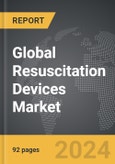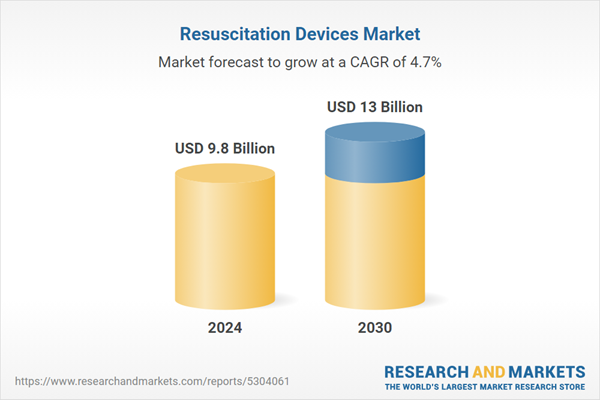The global market for Resuscitation Devices was valued at US$9.8 Billion in 2024 and is projected to reach US$13.0 Billion by 2030, growing at a CAGR of 4.7% from 2024 to 2030. This comprehensive report provides an in-depth analysis of market trends, drivers, and forecasts, helping you make informed business decisions. The report includes the most recent global tariff developments and how they impact the Resuscitation Devices market.
Segments: Product (Airway Management Devices, External Defibrillators, Convective Warming Blankets, Other Products); Patient Type (Adult, Pediatric); End-Use (Hospitals, ASCs & Cardiac Centers, Pre-Hospital Care Settings, Other End-Uses).
Geographic Regions/Countries: World; United States; Canada; Japan; China; Europe (France; Germany; Italy; United Kingdom; and Rest of Europe); Asia-Pacific; Rest of World.
The analysts continuously track trade developments worldwide, drawing insights from leading global economists and over 200 industry and policy institutions, including think tanks, trade organizations, and national economic advisory bodies. This intelligence is integrated into forecasting models to provide timely, data-driven analysis of emerging risks and opportunities.
Global Resuscitation Devices Market - Key Trends and Drivers Summarized
How Are Resuscitation Devices Revolutionizing Emergency Care?
Resuscitation devices are critical medical tools used to revive patients experiencing respiratory failure, cardiac arrest, or other life-threatening emergencies. These devices include automated external defibrillators (AEDs), resuscitation masks, and mechanical ventilators. They are primarily used in emergency rooms, ambulances, and intensive care units, providing timely life support to patients in critical conditions. With advancements in technology, modern resuscitation devices are designed for ease of use and portability, making them accessible to first responders, bystanders, and healthcare professionals alike. The increase in cases of cardiac arrest and respiratory emergencies globally has driven demand for resuscitation devices in both clinical and non-clinical settings.What Are the Key Segments in the Resuscitation Devices Market?
Major product types include defibrillators, ventilators, resuscitation masks, and resuscitation bags. Among these, defibrillators hold a significant market share due to their widespread use in cardiac emergencies. Mechanical ventilators are also essential, particularly in intensive care units and during the COVID-19 pandemic, when they became life-saving devices for patients with severe respiratory distress. Applications of resuscitation devices cover emergency care, intensive care units, and home healthcare, with emergency care representing the largest segment due to the prevalence of cardiac and respiratory emergencies. End-users of resuscitation devices include hospitals, emergency medical services, and home care settings. Hospitals dominate the market, utilizing a variety of resuscitation devices in emergency rooms, operating rooms, and ICUs. Emergency medical services (EMS) rely on portable resuscitation devices, especially AEDs, to provide immediate care to patients outside the hospital. Home care settings have also seen increased adoption of resuscitation devices, particularly for patients with chronic respiratory conditions or those at high risk of cardiac arrest, allowing families to deliver emergency support when needed.How Are Resuscitation Devices Integrated Across Medical Settings?
In hospitals, resuscitation devices like defibrillators and ventilators are essential in emergency rooms and ICUs, where rapid intervention can save lives. Emergency medical services use portable defibrillators and resuscitation bags in ambulances and other field settings, ensuring that patients receive life-saving treatment even before reaching the hospital. In home healthcare, resuscitation devices such as CPAP machines and portable ventilators are used for patients with chronic obstructive pulmonary disease (COPD) and other respiratory illnesses, offering them the ability to manage emergencies at home. The integration of user-friendly, compact devices has broadened the application of resuscitation technology across various settings.What Factors Are Driving the Growth in the Resuscitation Devices Market?
The growth in the Resuscitation Devices market is driven by several factors, including rising incidences of cardiac and respiratory conditions, advancements in medical technology, and increased awareness of emergency care. Innovations such as portable defibrillators, automated ventilators, and more intuitive user interfaces have enhanced the accessibility and effectiveness of resuscitation devices. The focus on reducing response times, improving patient outcomes, and increasing survival rates has further fueled demand, as resuscitation devices offer critical life support in emergencies. Additionally, expanding healthcare infrastructure, rising investments in EMS, and increased training in basic life support have contributed to market growth, supporting wider adoption in both clinical and community settings.Report Scope
The report analyzes the Resuscitation Devices market, presented in terms of units. The analysis covers the key segments and geographic regions outlined below.Segments: Product (Airway Management Devices, External Defibrillators, Convective Warming Blankets, Other Products); Patient Type (Adult, Pediatric); End-Use (Hospitals, ASCs & Cardiac Centers, Pre-Hospital Care Settings, Other End-Uses).
Geographic Regions/Countries: World; United States; Canada; Japan; China; Europe (France; Germany; Italy; United Kingdom; and Rest of Europe); Asia-Pacific; Rest of World.
Key Insights:
- Market Growth: Understand the significant growth trajectory of the Airway Management Devices segment, which is expected to reach US$6.6 Billion by 2030 with a CAGR of a 5.2%. The External Defibrillators segment is also set to grow at 4.6% CAGR over the analysis period.
- Regional Analysis: Gain insights into the U.S. market, valued at $2.7 Billion in 2024, and China, forecasted to grow at an impressive 4.5% CAGR to reach $2.1 Billion by 2030. Discover growth trends in other key regions, including Japan, Canada, Germany, and the Asia-Pacific.
Why You Should Buy This Report:
- Detailed Market Analysis: Access a thorough analysis of the Global Resuscitation Devices Market, covering all major geographic regions and market segments.
- Competitive Insights: Get an overview of the competitive landscape, including the market presence of major players across different geographies.
- Future Trends and Drivers: Understand the key trends and drivers shaping the future of the Global Resuscitation Devices Market.
- Actionable Insights: Benefit from actionable insights that can help you identify new revenue opportunities and make strategic business decisions.
Key Questions Answered:
- How is the Global Resuscitation Devices Market expected to evolve by 2030?
- What are the main drivers and restraints affecting the market?
- Which market segments will grow the most over the forecast period?
- How will market shares for different regions and segments change by 2030?
- Who are the leading players in the market, and what are their prospects?
Report Features:
- Comprehensive Market Data: Independent analysis of annual sales and market forecasts in US$ Million from 2024 to 2030.
- In-Depth Regional Analysis: Detailed insights into key markets, including the U.S., China, Japan, Canada, Europe, Asia-Pacific, Latin America, Middle East, and Africa.
- Company Profiles: Coverage of players such as 3M, Ambu, Cardinal Health, Drägerwerk AG & Co. KGaA, Flexicare and more.
- Complimentary Updates: Receive free report updates for one year to keep you informed of the latest market developments.
Some of the 36 companies featured in this Resuscitation Devices market report include:
- 3M
- Ambu
- Cardinal Health
- Drägerwerk AG & Co. KGaA
- Flexicare
- GE Healthcare
- Intersurgical
- Karl Storz
- Koninklijke Philips N.V.
- Medtronic
- Mindray Medical
- Nihon Kohden
- Physio-Control
- ResMed Inc.
- Salter Labs
- Smiths Medical
- Teleflex
- Verathon
- Vyaire Medical
- ZOLL Medical Corporation
Tariff Impact Analysis: Key Insights for 2025
Global tariff negotiations across 180+ countries are reshaping supply chains, costs, and competitiveness. This report reflects the latest developments as of April 2025 and incorporates forward-looking insights into the market outlook.The analysts continuously track trade developments worldwide, drawing insights from leading global economists and over 200 industry and policy institutions, including think tanks, trade organizations, and national economic advisory bodies. This intelligence is integrated into forecasting models to provide timely, data-driven analysis of emerging risks and opportunities.
What’s Included in This Edition:
- Tariff-adjusted market forecasts by region and segment
- Analysis of cost and supply chain implications by sourcing and trade exposure
- Strategic insights into geographic shifts
Buyers receive a free July 2025 update with:
- Finalized tariff impacts and new trade agreement effects
- Updated projections reflecting global sourcing and cost shifts
- Expanded country-specific coverage across the industry
Table of Contents
I. METHODOLOGYII. EXECUTIVE SUMMARY2. FOCUS ON SELECT PLAYERSIII. MARKET ANALYSISIV. COMPETITION
1. MARKET OVERVIEW
3. MARKET TRENDS & DRIVERS
4. GLOBAL MARKET PERSPECTIVE
UNITED STATES
CANADA
JAPAN
CHINA
EUROPE
FRANCE
GERMANY
ITALY
UNITED KINGDOM
REST OF EUROPE
ASIA-PACIFIC
REST OF WORLD
Companies Mentioned (Partial List)
A selection of companies mentioned in this report includes, but is not limited to:
- 3M
- Ambu
- Cardinal Health
- Drägerwerk AG & Co. KGaA
- Flexicare
- GE Healthcare
- Intersurgical
- Karl Storz
- Koninklijke Philips N.V.
- Medtronic
- Mindray Medical
- Nihon Kohden
- Physio-Control
- ResMed Inc.
- Salter Labs
- Smiths Medical
- Teleflex
- Verathon
- Vyaire Medical
- ZOLL Medical Corporation
Table Information
| Report Attribute | Details |
|---|---|
| No. of Pages | 92 |
| Published | April 2025 |
| Forecast Period | 2024 - 2030 |
| Estimated Market Value ( USD | $ 9.8 Billion |
| Forecasted Market Value ( USD | $ 13 Billion |
| Compound Annual Growth Rate | 4.7% |
| Regions Covered | Global |









